Strategic Direction Report: DataTrack Strategic Planning and Vision
VerifiedAdded on 2022/11/19
|22
|5322
|459
Report
AI Summary
This report, prepared for Coverhill Limited, analyzes the strategic direction of DataTrack, a major IT service organization in Saudi Arabia. It explores the relationship between vision, strategic direction, and strategic planning, highlighting the importance of aligning organizational vision with mission and values. The report examines factors impacting organizational vision, including internal and external influences, and emphasizes the roles of leadership, transparency, and communication in successful strategic implementation. It details the processes involved in creating and communicating a vision, as well as the challenges faced and the leadership behaviors that promote the achievement of organizational goals. The report also provides a project proposal for DataTrack, focusing on the development of a strategic vision and direction to help them achieve their goals. The consultant role involves managing the project proposal and encouraging critical thinking about strategic management, vision development, and implementation. The report emphasizes the importance of stakeholder engagement, leadership, and employee skill development in achieving strategic goals.

Running head: STRATEGIC DIRECTION
Strategic direction
Name of student
Name of University
Author note
Strategic direction
Name of student
Name of University
Author note
Paraphrase This Document
Need a fresh take? Get an instant paraphrase of this document with our AI Paraphraser
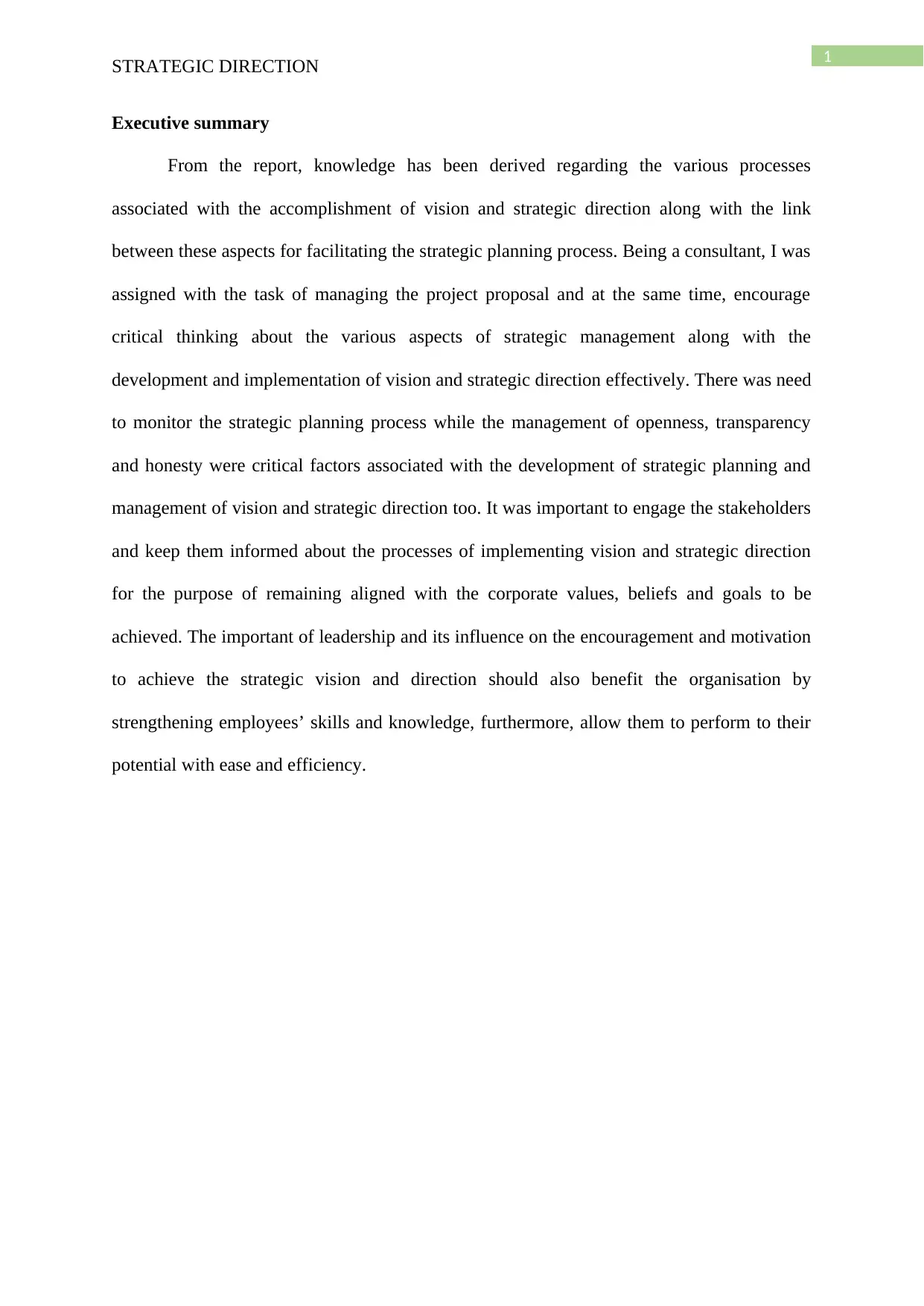
1
STRATEGIC DIRECTION
Executive summary
From the report, knowledge has been derived regarding the various processes
associated with the accomplishment of vision and strategic direction along with the link
between these aspects for facilitating the strategic planning process. Being a consultant, I was
assigned with the task of managing the project proposal and at the same time, encourage
critical thinking about the various aspects of strategic management along with the
development and implementation of vision and strategic direction effectively. There was need
to monitor the strategic planning process while the management of openness, transparency
and honesty were critical factors associated with the development of strategic planning and
management of vision and strategic direction too. It was important to engage the stakeholders
and keep them informed about the processes of implementing vision and strategic direction
for the purpose of remaining aligned with the corporate values, beliefs and goals to be
achieved. The important of leadership and its influence on the encouragement and motivation
to achieve the strategic vision and direction should also benefit the organisation by
strengthening employees’ skills and knowledge, furthermore, allow them to perform to their
potential with ease and efficiency.
STRATEGIC DIRECTION
Executive summary
From the report, knowledge has been derived regarding the various processes
associated with the accomplishment of vision and strategic direction along with the link
between these aspects for facilitating the strategic planning process. Being a consultant, I was
assigned with the task of managing the project proposal and at the same time, encourage
critical thinking about the various aspects of strategic management along with the
development and implementation of vision and strategic direction effectively. There was need
to monitor the strategic planning process while the management of openness, transparency
and honesty were critical factors associated with the development of strategic planning and
management of vision and strategic direction too. It was important to engage the stakeholders
and keep them informed about the processes of implementing vision and strategic direction
for the purpose of remaining aligned with the corporate values, beliefs and goals to be
achieved. The important of leadership and its influence on the encouragement and motivation
to achieve the strategic vision and direction should also benefit the organisation by
strengthening employees’ skills and knowledge, furthermore, allow them to perform to their
potential with ease and efficiency.
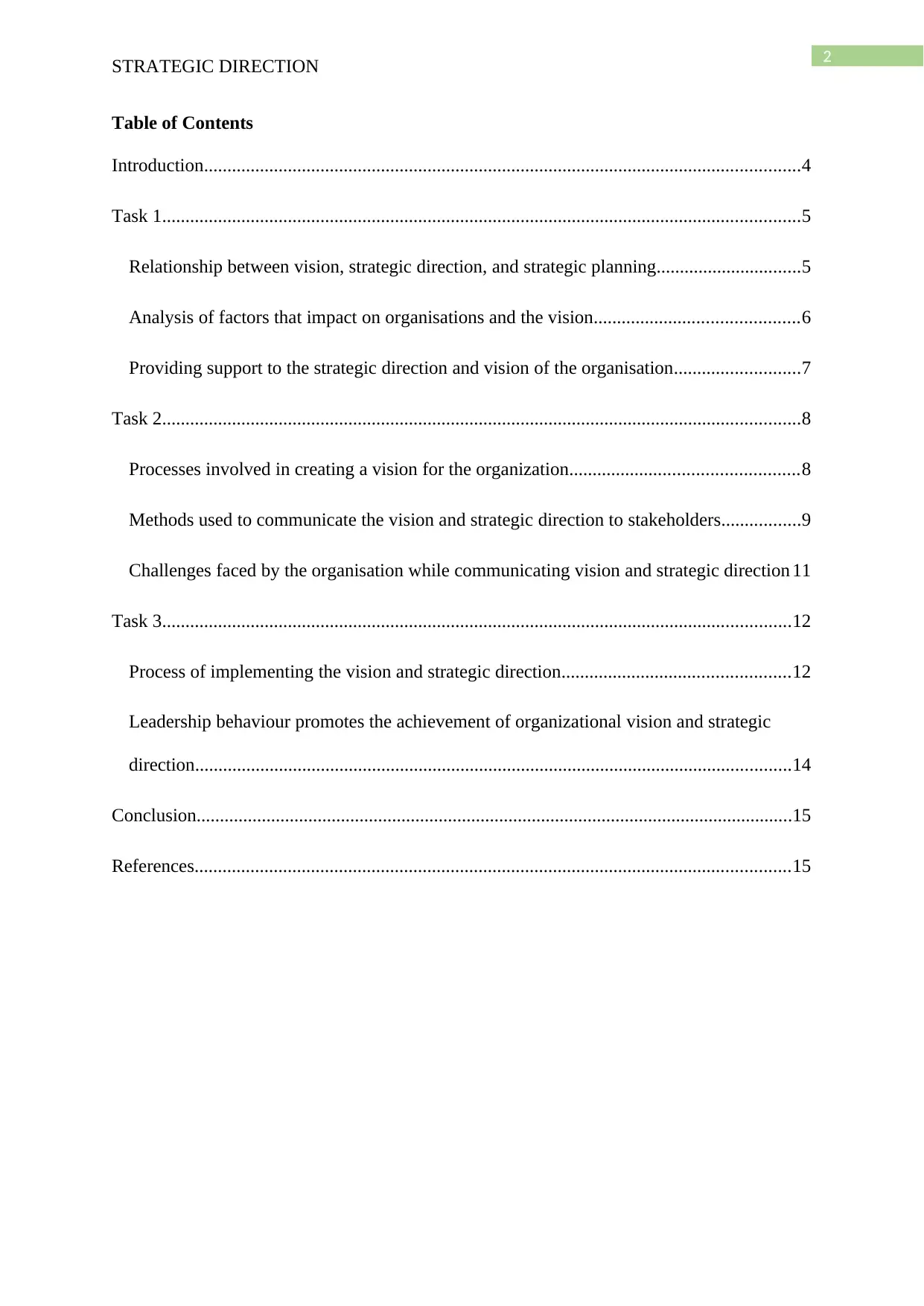
2
STRATEGIC DIRECTION
Table of Contents
Introduction................................................................................................................................4
Task 1.........................................................................................................................................5
Relationship between vision, strategic direction, and strategic planning...............................5
Analysis of factors that impact on organisations and the vision............................................6
Providing support to the strategic direction and vision of the organisation...........................7
Task 2.........................................................................................................................................8
Processes involved in creating a vision for the organization.................................................8
Methods used to communicate the vision and strategic direction to stakeholders.................9
Challenges faced by the organisation while communicating vision and strategic direction 11
Task 3.......................................................................................................................................12
Process of implementing the vision and strategic direction.................................................12
Leadership behaviour promotes the achievement of organizational vision and strategic
direction................................................................................................................................14
Conclusion................................................................................................................................15
References................................................................................................................................15
STRATEGIC DIRECTION
Table of Contents
Introduction................................................................................................................................4
Task 1.........................................................................................................................................5
Relationship between vision, strategic direction, and strategic planning...............................5
Analysis of factors that impact on organisations and the vision............................................6
Providing support to the strategic direction and vision of the organisation...........................7
Task 2.........................................................................................................................................8
Processes involved in creating a vision for the organization.................................................8
Methods used to communicate the vision and strategic direction to stakeholders.................9
Challenges faced by the organisation while communicating vision and strategic direction 11
Task 3.......................................................................................................................................12
Process of implementing the vision and strategic direction.................................................12
Leadership behaviour promotes the achievement of organizational vision and strategic
direction................................................................................................................................14
Conclusion................................................................................................................................15
References................................................................................................................................15
⊘ This is a preview!⊘
Do you want full access?
Subscribe today to unlock all pages.

Trusted by 1+ million students worldwide
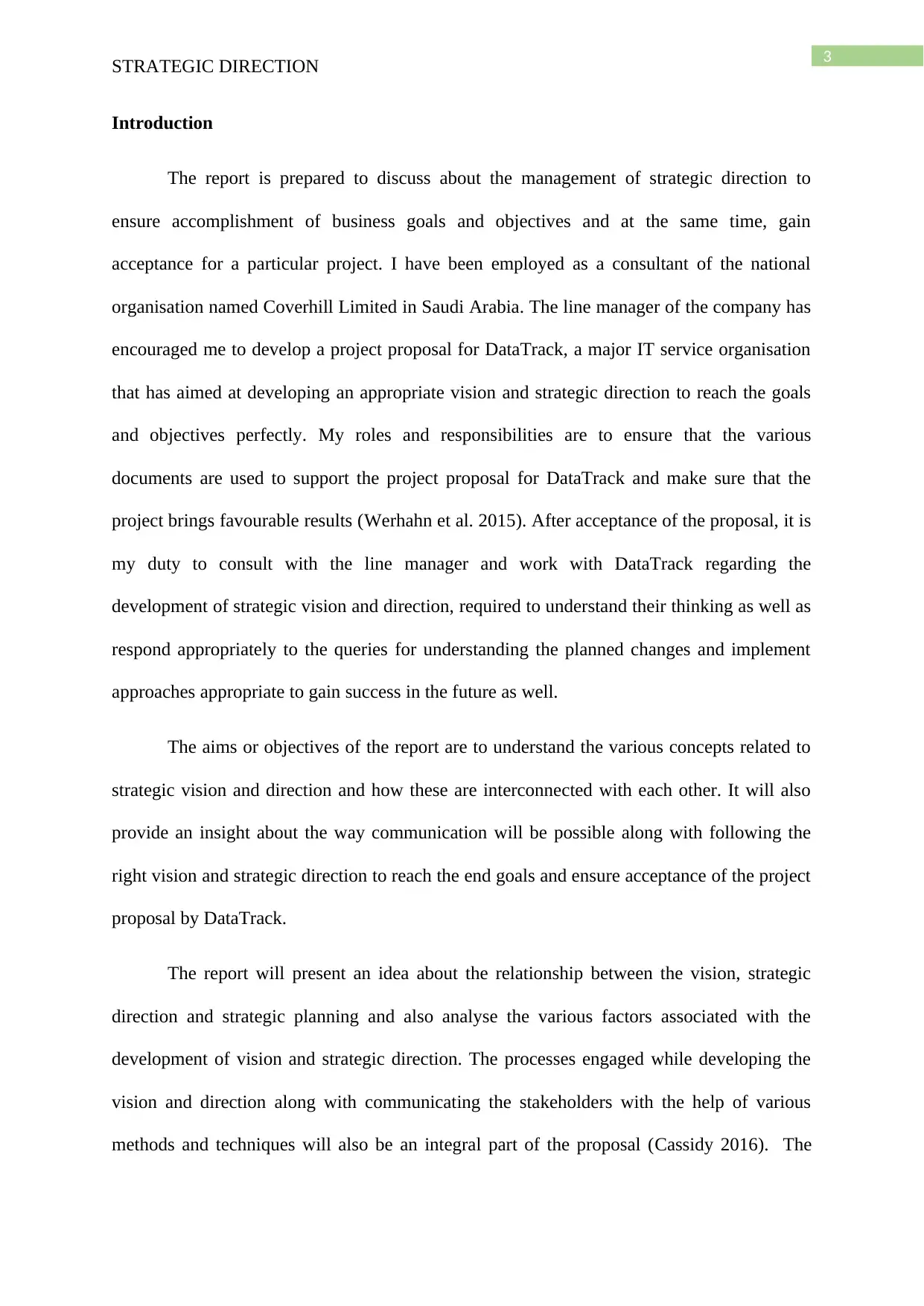
3
STRATEGIC DIRECTION
Introduction
The report is prepared to discuss about the management of strategic direction to
ensure accomplishment of business goals and objectives and at the same time, gain
acceptance for a particular project. I have been employed as a consultant of the national
organisation named Coverhill Limited in Saudi Arabia. The line manager of the company has
encouraged me to develop a project proposal for DataTrack, a major IT service organisation
that has aimed at developing an appropriate vision and strategic direction to reach the goals
and objectives perfectly. My roles and responsibilities are to ensure that the various
documents are used to support the project proposal for DataTrack and make sure that the
project brings favourable results (Werhahn et al. 2015). After acceptance of the proposal, it is
my duty to consult with the line manager and work with DataTrack regarding the
development of strategic vision and direction, required to understand their thinking as well as
respond appropriately to the queries for understanding the planned changes and implement
approaches appropriate to gain success in the future as well.
The aims or objectives of the report are to understand the various concepts related to
strategic vision and direction and how these are interconnected with each other. It will also
provide an insight about the way communication will be possible along with following the
right vision and strategic direction to reach the end goals and ensure acceptance of the project
proposal by DataTrack.
The report will present an idea about the relationship between the vision, strategic
direction and strategic planning and also analyse the various factors associated with the
development of vision and strategic direction. The processes engaged while developing the
vision and direction along with communicating the stakeholders with the help of various
methods and techniques will also be an integral part of the proposal (Cassidy 2016). The
STRATEGIC DIRECTION
Introduction
The report is prepared to discuss about the management of strategic direction to
ensure accomplishment of business goals and objectives and at the same time, gain
acceptance for a particular project. I have been employed as a consultant of the national
organisation named Coverhill Limited in Saudi Arabia. The line manager of the company has
encouraged me to develop a project proposal for DataTrack, a major IT service organisation
that has aimed at developing an appropriate vision and strategic direction to reach the goals
and objectives perfectly. My roles and responsibilities are to ensure that the various
documents are used to support the project proposal for DataTrack and make sure that the
project brings favourable results (Werhahn et al. 2015). After acceptance of the proposal, it is
my duty to consult with the line manager and work with DataTrack regarding the
development of strategic vision and direction, required to understand their thinking as well as
respond appropriately to the queries for understanding the planned changes and implement
approaches appropriate to gain success in the future as well.
The aims or objectives of the report are to understand the various concepts related to
strategic vision and direction and how these are interconnected with each other. It will also
provide an insight about the way communication will be possible along with following the
right vision and strategic direction to reach the end goals and ensure acceptance of the project
proposal by DataTrack.
The report will present an idea about the relationship between the vision, strategic
direction and strategic planning and also analyse the various factors associated with the
development of vision and strategic direction. The processes engaged while developing the
vision and direction along with communicating the stakeholders with the help of various
methods and techniques will also be an integral part of the proposal (Cassidy 2016). The
Paraphrase This Document
Need a fresh take? Get an instant paraphrase of this document with our AI Paraphraser
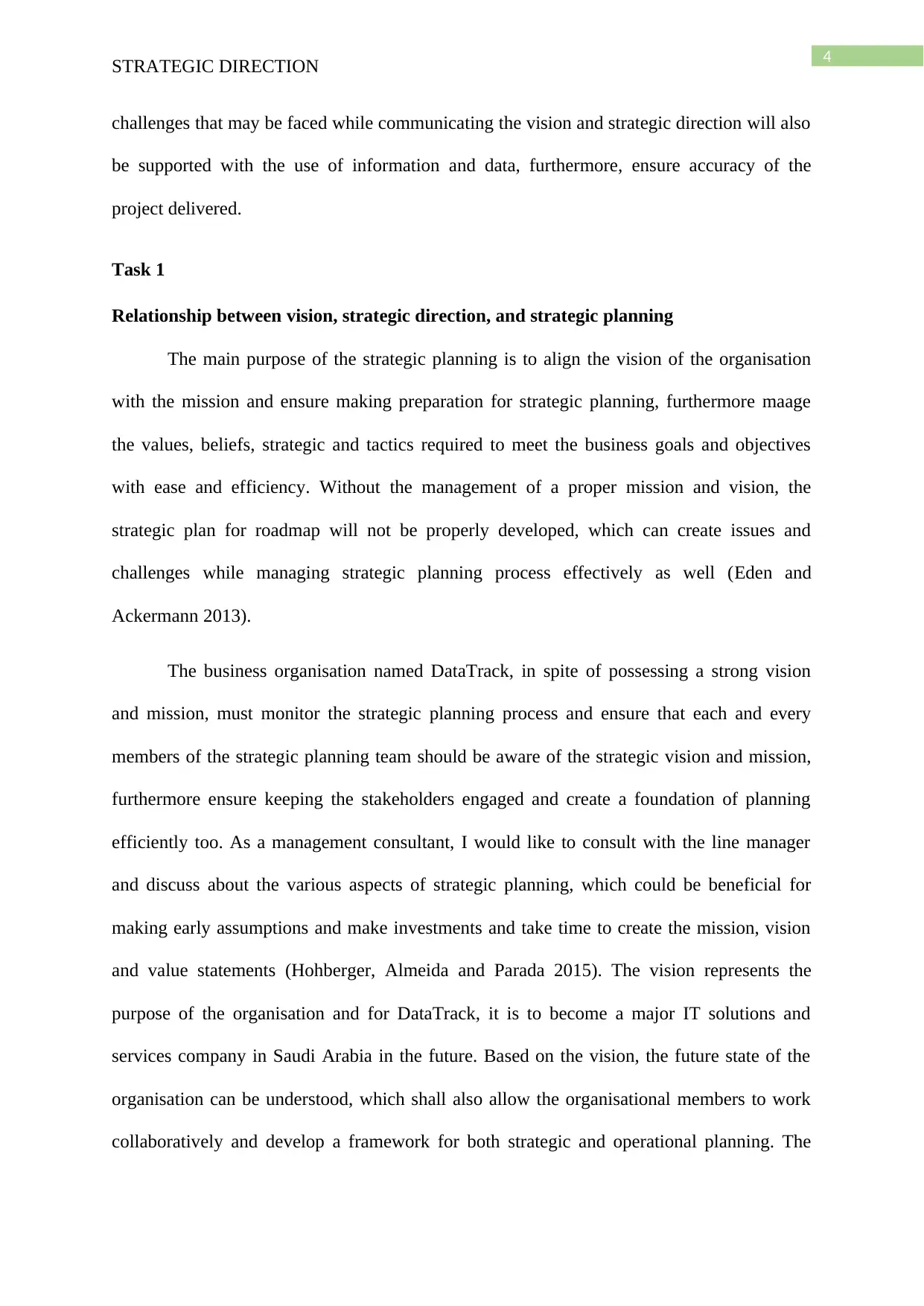
4
STRATEGIC DIRECTION
challenges that may be faced while communicating the vision and strategic direction will also
be supported with the use of information and data, furthermore, ensure accuracy of the
project delivered.
Task 1
Relationship between vision, strategic direction, and strategic planning
The main purpose of the strategic planning is to align the vision of the organisation
with the mission and ensure making preparation for strategic planning, furthermore maage
the values, beliefs, strategic and tactics required to meet the business goals and objectives
with ease and efficiency. Without the management of a proper mission and vision, the
strategic plan for roadmap will not be properly developed, which can create issues and
challenges while managing strategic planning process effectively as well (Eden and
Ackermann 2013).
The business organisation named DataTrack, in spite of possessing a strong vision
and mission, must monitor the strategic planning process and ensure that each and every
members of the strategic planning team should be aware of the strategic vision and mission,
furthermore ensure keeping the stakeholders engaged and create a foundation of planning
efficiently too. As a management consultant, I would like to consult with the line manager
and discuss about the various aspects of strategic planning, which could be beneficial for
making early assumptions and make investments and take time to create the mission, vision
and value statements (Hohberger, Almeida and Parada 2015). The vision represents the
purpose of the organisation and for DataTrack, it is to become a major IT solutions and
services company in Saudi Arabia in the future. Based on the vision, the future state of the
organisation can be understood, which shall also allow the organisational members to work
collaboratively and develop a framework for both strategic and operational planning. The
STRATEGIC DIRECTION
challenges that may be faced while communicating the vision and strategic direction will also
be supported with the use of information and data, furthermore, ensure accuracy of the
project delivered.
Task 1
Relationship between vision, strategic direction, and strategic planning
The main purpose of the strategic planning is to align the vision of the organisation
with the mission and ensure making preparation for strategic planning, furthermore maage
the values, beliefs, strategic and tactics required to meet the business goals and objectives
with ease and efficiency. Without the management of a proper mission and vision, the
strategic plan for roadmap will not be properly developed, which can create issues and
challenges while managing strategic planning process effectively as well (Eden and
Ackermann 2013).
The business organisation named DataTrack, in spite of possessing a strong vision
and mission, must monitor the strategic planning process and ensure that each and every
members of the strategic planning team should be aware of the strategic vision and mission,
furthermore ensure keeping the stakeholders engaged and create a foundation of planning
efficiently too. As a management consultant, I would like to consult with the line manager
and discuss about the various aspects of strategic planning, which could be beneficial for
making early assumptions and make investments and take time to create the mission, vision
and value statements (Hohberger, Almeida and Parada 2015). The vision represents the
purpose of the organisation and for DataTrack, it is to become a major IT solutions and
services company in Saudi Arabia in the future. Based on the vision, the future state of the
organisation can be understood, which shall also allow the organisational members to work
collaboratively and develop a framework for both strategic and operational planning. The
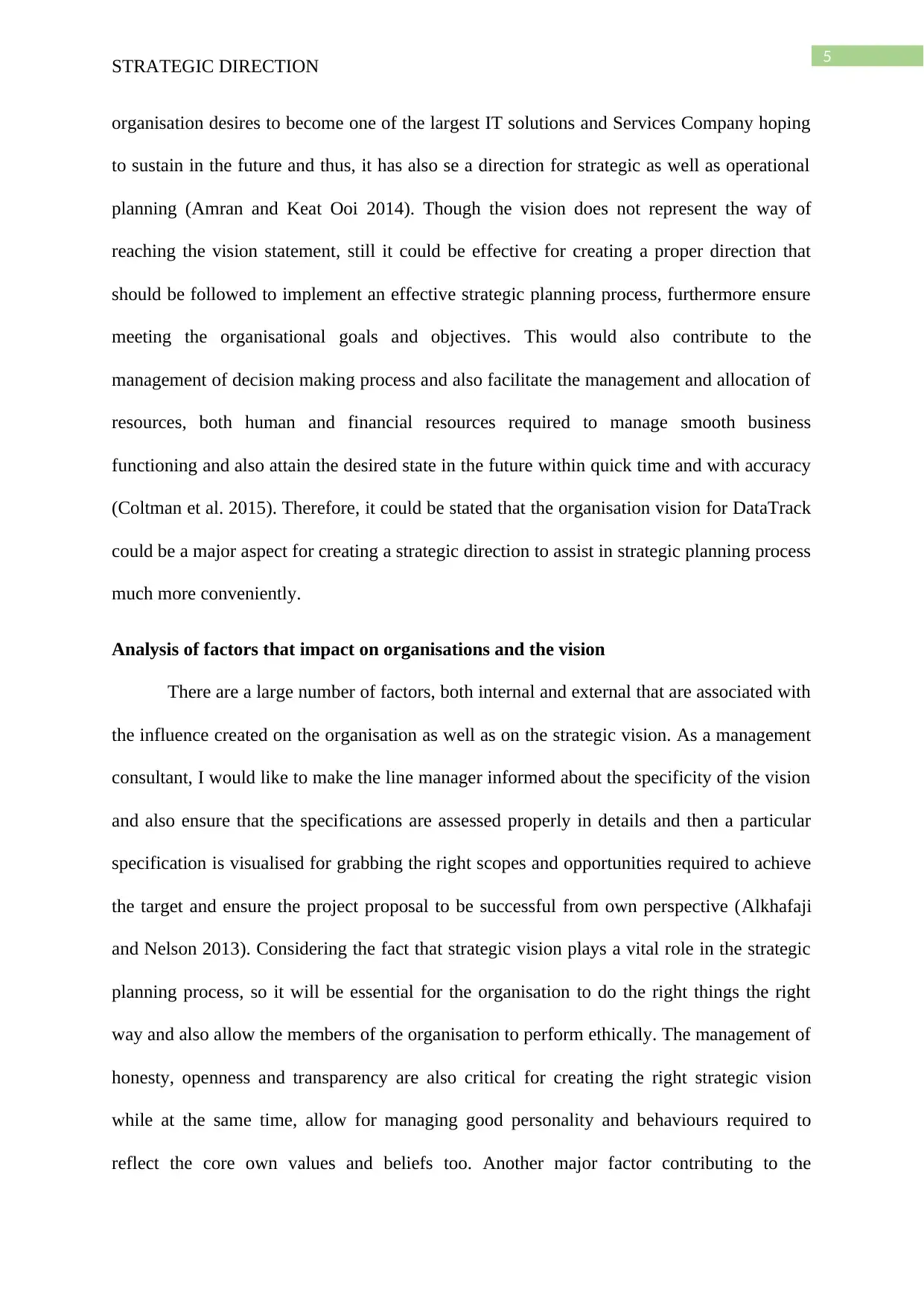
5
STRATEGIC DIRECTION
organisation desires to become one of the largest IT solutions and Services Company hoping
to sustain in the future and thus, it has also se a direction for strategic as well as operational
planning (Amran and Keat Ooi 2014). Though the vision does not represent the way of
reaching the vision statement, still it could be effective for creating a proper direction that
should be followed to implement an effective strategic planning process, furthermore ensure
meeting the organisational goals and objectives. This would also contribute to the
management of decision making process and also facilitate the management and allocation of
resources, both human and financial resources required to manage smooth business
functioning and also attain the desired state in the future within quick time and with accuracy
(Coltman et al. 2015). Therefore, it could be stated that the organisation vision for DataTrack
could be a major aspect for creating a strategic direction to assist in strategic planning process
much more conveniently.
Analysis of factors that impact on organisations and the vision
There are a large number of factors, both internal and external that are associated with
the influence created on the organisation as well as on the strategic vision. As a management
consultant, I would like to make the line manager informed about the specificity of the vision
and also ensure that the specifications are assessed properly in details and then a particular
specification is visualised for grabbing the right scopes and opportunities required to achieve
the target and ensure the project proposal to be successful from own perspective (Alkhafaji
and Nelson 2013). Considering the fact that strategic vision plays a vital role in the strategic
planning process, so it will be essential for the organisation to do the right things the right
way and also allow the members of the organisation to perform ethically. The management of
honesty, openness and transparency are also critical for creating the right strategic vision
while at the same time, allow for managing good personality and behaviours required to
reflect the core own values and beliefs too. Another major factor contributing to the
STRATEGIC DIRECTION
organisation desires to become one of the largest IT solutions and Services Company hoping
to sustain in the future and thus, it has also se a direction for strategic as well as operational
planning (Amran and Keat Ooi 2014). Though the vision does not represent the way of
reaching the vision statement, still it could be effective for creating a proper direction that
should be followed to implement an effective strategic planning process, furthermore ensure
meeting the organisational goals and objectives. This would also contribute to the
management of decision making process and also facilitate the management and allocation of
resources, both human and financial resources required to manage smooth business
functioning and also attain the desired state in the future within quick time and with accuracy
(Coltman et al. 2015). Therefore, it could be stated that the organisation vision for DataTrack
could be a major aspect for creating a strategic direction to assist in strategic planning process
much more conveniently.
Analysis of factors that impact on organisations and the vision
There are a large number of factors, both internal and external that are associated with
the influence created on the organisation as well as on the strategic vision. As a management
consultant, I would like to make the line manager informed about the specificity of the vision
and also ensure that the specifications are assessed properly in details and then a particular
specification is visualised for grabbing the right scopes and opportunities required to achieve
the target and ensure the project proposal to be successful from own perspective (Alkhafaji
and Nelson 2013). Considering the fact that strategic vision plays a vital role in the strategic
planning process, so it will be essential for the organisation to do the right things the right
way and also allow the members of the organisation to perform ethically. The management of
honesty, openness and transparency are also critical for creating the right strategic vision
while at the same time, allow for managing good personality and behaviours required to
reflect the core own values and beliefs too. Another major factor contributing to the
⊘ This is a preview!⊘
Do you want full access?
Subscribe today to unlock all pages.

Trusted by 1+ million students worldwide
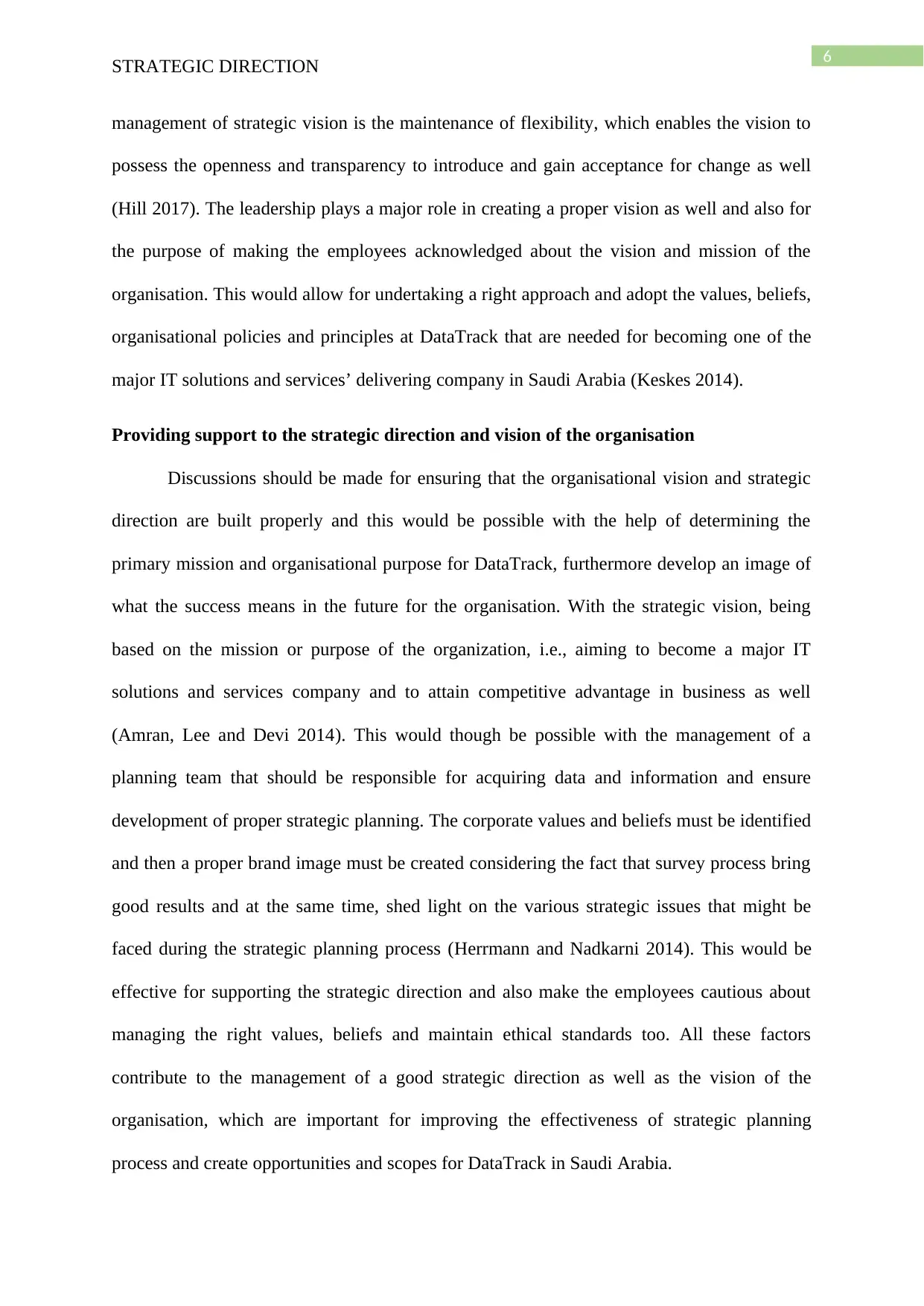
6
STRATEGIC DIRECTION
management of strategic vision is the maintenance of flexibility, which enables the vision to
possess the openness and transparency to introduce and gain acceptance for change as well
(Hill 2017). The leadership plays a major role in creating a proper vision as well and also for
the purpose of making the employees acknowledged about the vision and mission of the
organisation. This would allow for undertaking a right approach and adopt the values, beliefs,
organisational policies and principles at DataTrack that are needed for becoming one of the
major IT solutions and services’ delivering company in Saudi Arabia (Keskes 2014).
Providing support to the strategic direction and vision of the organisation
Discussions should be made for ensuring that the organisational vision and strategic
direction are built properly and this would be possible with the help of determining the
primary mission and organisational purpose for DataTrack, furthermore develop an image of
what the success means in the future for the organisation. With the strategic vision, being
based on the mission or purpose of the organization, i.e., aiming to become a major IT
solutions and services company and to attain competitive advantage in business as well
(Amran, Lee and Devi 2014). This would though be possible with the management of a
planning team that should be responsible for acquiring data and information and ensure
development of proper strategic planning. The corporate values and beliefs must be identified
and then a proper brand image must be created considering the fact that survey process bring
good results and at the same time, shed light on the various strategic issues that might be
faced during the strategic planning process (Herrmann and Nadkarni 2014). This would be
effective for supporting the strategic direction and also make the employees cautious about
managing the right values, beliefs and maintain ethical standards too. All these factors
contribute to the management of a good strategic direction as well as the vision of the
organisation, which are important for improving the effectiveness of strategic planning
process and create opportunities and scopes for DataTrack in Saudi Arabia.
STRATEGIC DIRECTION
management of strategic vision is the maintenance of flexibility, which enables the vision to
possess the openness and transparency to introduce and gain acceptance for change as well
(Hill 2017). The leadership plays a major role in creating a proper vision as well and also for
the purpose of making the employees acknowledged about the vision and mission of the
organisation. This would allow for undertaking a right approach and adopt the values, beliefs,
organisational policies and principles at DataTrack that are needed for becoming one of the
major IT solutions and services’ delivering company in Saudi Arabia (Keskes 2014).
Providing support to the strategic direction and vision of the organisation
Discussions should be made for ensuring that the organisational vision and strategic
direction are built properly and this would be possible with the help of determining the
primary mission and organisational purpose for DataTrack, furthermore develop an image of
what the success means in the future for the organisation. With the strategic vision, being
based on the mission or purpose of the organization, i.e., aiming to become a major IT
solutions and services company and to attain competitive advantage in business as well
(Amran, Lee and Devi 2014). This would though be possible with the management of a
planning team that should be responsible for acquiring data and information and ensure
development of proper strategic planning. The corporate values and beliefs must be identified
and then a proper brand image must be created considering the fact that survey process bring
good results and at the same time, shed light on the various strategic issues that might be
faced during the strategic planning process (Herrmann and Nadkarni 2014). This would be
effective for supporting the strategic direction and also make the employees cautious about
managing the right values, beliefs and maintain ethical standards too. All these factors
contribute to the management of a good strategic direction as well as the vision of the
organisation, which are important for improving the effectiveness of strategic planning
process and create opportunities and scopes for DataTrack in Saudi Arabia.
Paraphrase This Document
Need a fresh take? Get an instant paraphrase of this document with our AI Paraphraser
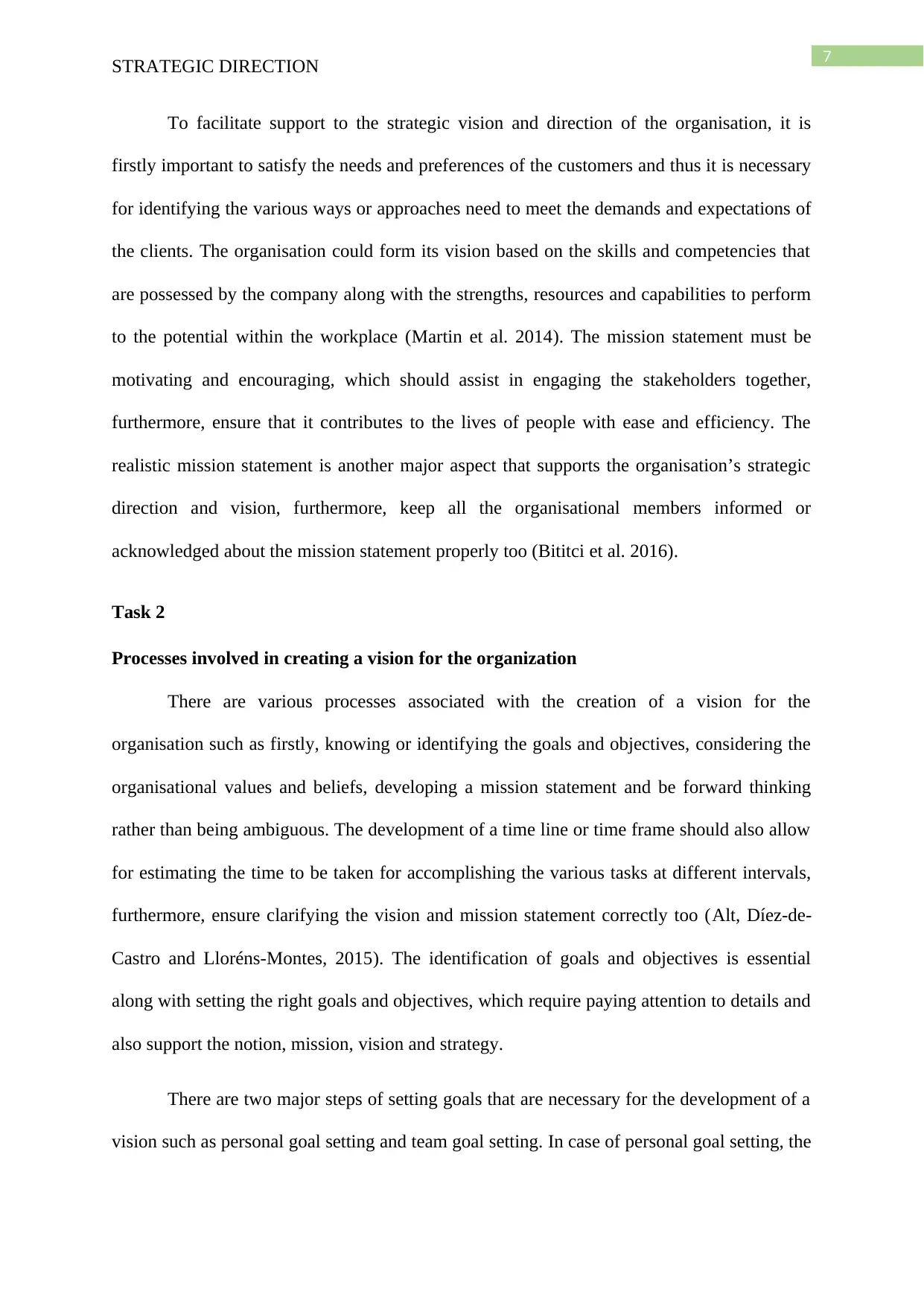
7
STRATEGIC DIRECTION
To facilitate support to the strategic vision and direction of the organisation, it is
firstly important to satisfy the needs and preferences of the customers and thus it is necessary
for identifying the various ways or approaches need to meet the demands and expectations of
the clients. The organisation could form its vision based on the skills and competencies that
are possessed by the company along with the strengths, resources and capabilities to perform
to the potential within the workplace (Martin et al. 2014). The mission statement must be
motivating and encouraging, which should assist in engaging the stakeholders together,
furthermore, ensure that it contributes to the lives of people with ease and efficiency. The
realistic mission statement is another major aspect that supports the organisation’s strategic
direction and vision, furthermore, keep all the organisational members informed or
acknowledged about the mission statement properly too (Bititci et al. 2016).
Task 2
Processes involved in creating a vision for the organization
There are various processes associated with the creation of a vision for the
organisation such as firstly, knowing or identifying the goals and objectives, considering the
organisational values and beliefs, developing a mission statement and be forward thinking
rather than being ambiguous. The development of a time line or time frame should also allow
for estimating the time to be taken for accomplishing the various tasks at different intervals,
furthermore, ensure clarifying the vision and mission statement correctly too (Alt, Díez-de-
Castro and Lloréns-Montes, 2015). The identification of goals and objectives is essential
along with setting the right goals and objectives, which require paying attention to details and
also support the notion, mission, vision and strategy.
There are two major steps of setting goals that are necessary for the development of a
vision such as personal goal setting and team goal setting. In case of personal goal setting, the
STRATEGIC DIRECTION
To facilitate support to the strategic vision and direction of the organisation, it is
firstly important to satisfy the needs and preferences of the customers and thus it is necessary
for identifying the various ways or approaches need to meet the demands and expectations of
the clients. The organisation could form its vision based on the skills and competencies that
are possessed by the company along with the strengths, resources and capabilities to perform
to the potential within the workplace (Martin et al. 2014). The mission statement must be
motivating and encouraging, which should assist in engaging the stakeholders together,
furthermore, ensure that it contributes to the lives of people with ease and efficiency. The
realistic mission statement is another major aspect that supports the organisation’s strategic
direction and vision, furthermore, keep all the organisational members informed or
acknowledged about the mission statement properly too (Bititci et al. 2016).
Task 2
Processes involved in creating a vision for the organization
There are various processes associated with the creation of a vision for the
organisation such as firstly, knowing or identifying the goals and objectives, considering the
organisational values and beliefs, developing a mission statement and be forward thinking
rather than being ambiguous. The development of a time line or time frame should also allow
for estimating the time to be taken for accomplishing the various tasks at different intervals,
furthermore, ensure clarifying the vision and mission statement correctly too (Alt, Díez-de-
Castro and Lloréns-Montes, 2015). The identification of goals and objectives is essential
along with setting the right goals and objectives, which require paying attention to details and
also support the notion, mission, vision and strategy.
There are two major steps of setting goals that are necessary for the development of a
vision such as personal goal setting and team goal setting. In case of personal goal setting, the
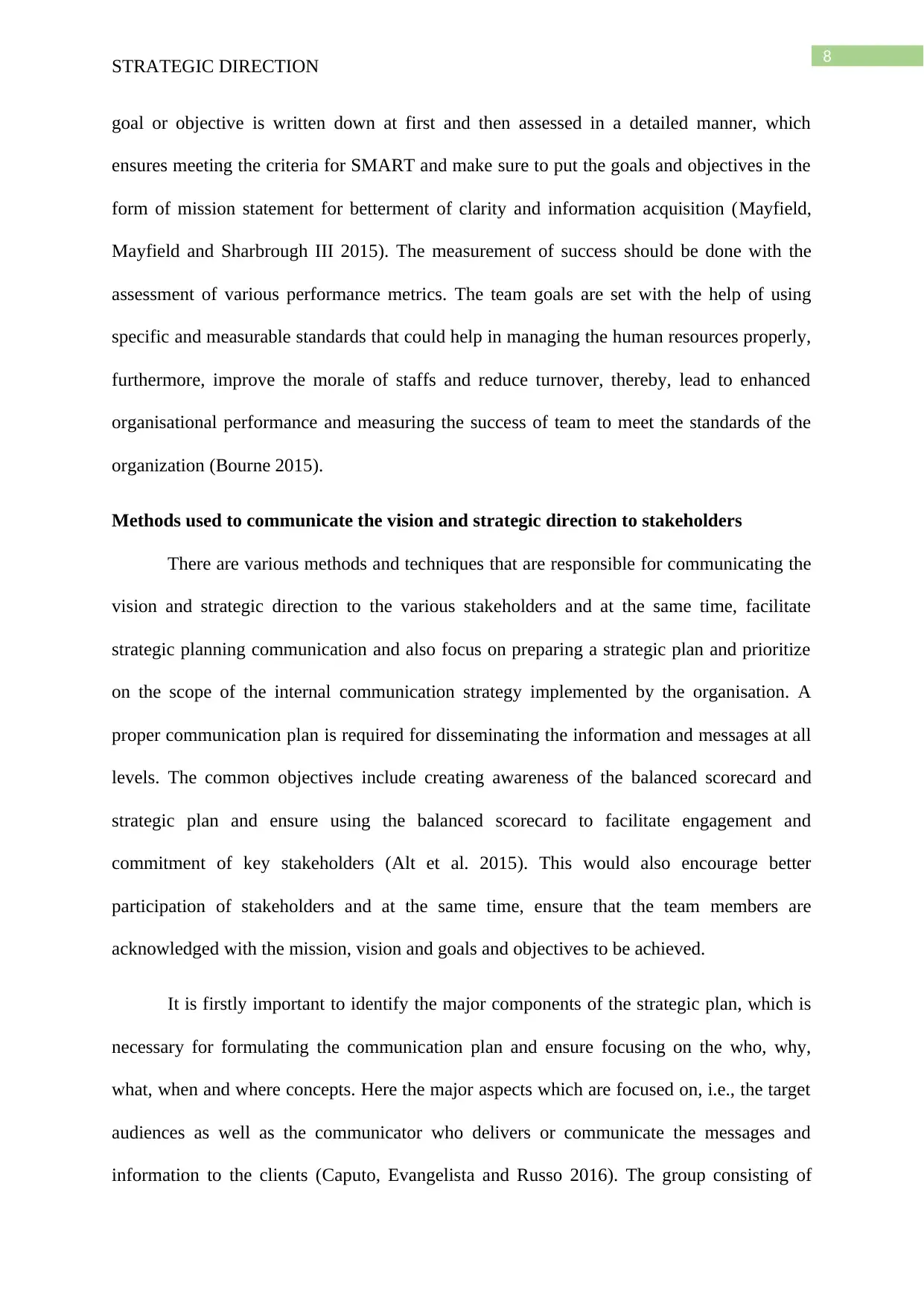
8
STRATEGIC DIRECTION
goal or objective is written down at first and then assessed in a detailed manner, which
ensures meeting the criteria for SMART and make sure to put the goals and objectives in the
form of mission statement for betterment of clarity and information acquisition (Mayfield,
Mayfield and Sharbrough III 2015). The measurement of success should be done with the
assessment of various performance metrics. The team goals are set with the help of using
specific and measurable standards that could help in managing the human resources properly,
furthermore, improve the morale of staffs and reduce turnover, thereby, lead to enhanced
organisational performance and measuring the success of team to meet the standards of the
organization (Bourne 2015).
Methods used to communicate the vision and strategic direction to stakeholders
There are various methods and techniques that are responsible for communicating the
vision and strategic direction to the various stakeholders and at the same time, facilitate
strategic planning communication and also focus on preparing a strategic plan and prioritize
on the scope of the internal communication strategy implemented by the organisation. A
proper communication plan is required for disseminating the information and messages at all
levels. The common objectives include creating awareness of the balanced scorecard and
strategic plan and ensure using the balanced scorecard to facilitate engagement and
commitment of key stakeholders (Alt et al. 2015). This would also encourage better
participation of stakeholders and at the same time, ensure that the team members are
acknowledged with the mission, vision and goals and objectives to be achieved.
It is firstly important to identify the major components of the strategic plan, which is
necessary for formulating the communication plan and ensure focusing on the who, why,
what, when and where concepts. Here the major aspects which are focused on, i.e., the target
audiences as well as the communicator who delivers or communicate the messages and
information to the clients (Caputo, Evangelista and Russo 2016). The group consisting of
STRATEGIC DIRECTION
goal or objective is written down at first and then assessed in a detailed manner, which
ensures meeting the criteria for SMART and make sure to put the goals and objectives in the
form of mission statement for betterment of clarity and information acquisition (Mayfield,
Mayfield and Sharbrough III 2015). The measurement of success should be done with the
assessment of various performance metrics. The team goals are set with the help of using
specific and measurable standards that could help in managing the human resources properly,
furthermore, improve the morale of staffs and reduce turnover, thereby, lead to enhanced
organisational performance and measuring the success of team to meet the standards of the
organization (Bourne 2015).
Methods used to communicate the vision and strategic direction to stakeholders
There are various methods and techniques that are responsible for communicating the
vision and strategic direction to the various stakeholders and at the same time, facilitate
strategic planning communication and also focus on preparing a strategic plan and prioritize
on the scope of the internal communication strategy implemented by the organisation. A
proper communication plan is required for disseminating the information and messages at all
levels. The common objectives include creating awareness of the balanced scorecard and
strategic plan and ensure using the balanced scorecard to facilitate engagement and
commitment of key stakeholders (Alt et al. 2015). This would also encourage better
participation of stakeholders and at the same time, ensure that the team members are
acknowledged with the mission, vision and goals and objectives to be achieved.
It is firstly important to identify the major components of the strategic plan, which is
necessary for formulating the communication plan and ensure focusing on the who, why,
what, when and where concepts. Here the major aspects which are focused on, i.e., the target
audiences as well as the communicator who delivers or communicate the messages and
information to the clients (Caputo, Evangelista and Russo 2016). The group consisting of
⊘ This is a preview!⊘
Do you want full access?
Subscribe today to unlock all pages.

Trusted by 1+ million students worldwide
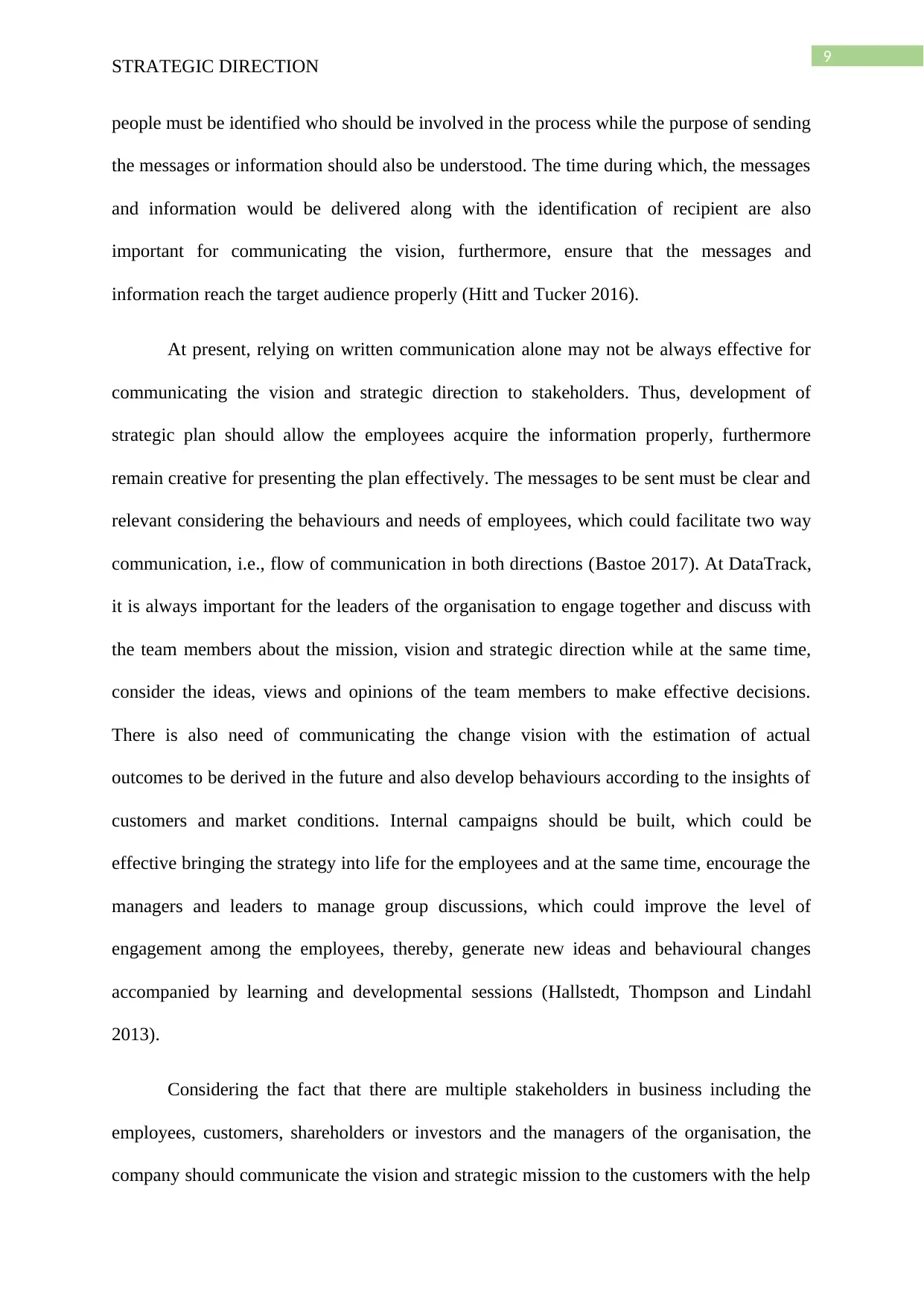
9
STRATEGIC DIRECTION
people must be identified who should be involved in the process while the purpose of sending
the messages or information should also be understood. The time during which, the messages
and information would be delivered along with the identification of recipient are also
important for communicating the vision, furthermore, ensure that the messages and
information reach the target audience properly (Hitt and Tucker 2016).
At present, relying on written communication alone may not be always effective for
communicating the vision and strategic direction to stakeholders. Thus, development of
strategic plan should allow the employees acquire the information properly, furthermore
remain creative for presenting the plan effectively. The messages to be sent must be clear and
relevant considering the behaviours and needs of employees, which could facilitate two way
communication, i.e., flow of communication in both directions (Bastoe 2017). At DataTrack,
it is always important for the leaders of the organisation to engage together and discuss with
the team members about the mission, vision and strategic direction while at the same time,
consider the ideas, views and opinions of the team members to make effective decisions.
There is also need of communicating the change vision with the estimation of actual
outcomes to be derived in the future and also develop behaviours according to the insights of
customers and market conditions. Internal campaigns should be built, which could be
effective bringing the strategy into life for the employees and at the same time, encourage the
managers and leaders to manage group discussions, which could improve the level of
engagement among the employees, thereby, generate new ideas and behavioural changes
accompanied by learning and developmental sessions (Hallstedt, Thompson and Lindahl
2013).
Considering the fact that there are multiple stakeholders in business including the
employees, customers, shareholders or investors and the managers of the organisation, the
company should communicate the vision and strategic mission to the customers with the help
STRATEGIC DIRECTION
people must be identified who should be involved in the process while the purpose of sending
the messages or information should also be understood. The time during which, the messages
and information would be delivered along with the identification of recipient are also
important for communicating the vision, furthermore, ensure that the messages and
information reach the target audience properly (Hitt and Tucker 2016).
At present, relying on written communication alone may not be always effective for
communicating the vision and strategic direction to stakeholders. Thus, development of
strategic plan should allow the employees acquire the information properly, furthermore
remain creative for presenting the plan effectively. The messages to be sent must be clear and
relevant considering the behaviours and needs of employees, which could facilitate two way
communication, i.e., flow of communication in both directions (Bastoe 2017). At DataTrack,
it is always important for the leaders of the organisation to engage together and discuss with
the team members about the mission, vision and strategic direction while at the same time,
consider the ideas, views and opinions of the team members to make effective decisions.
There is also need of communicating the change vision with the estimation of actual
outcomes to be derived in the future and also develop behaviours according to the insights of
customers and market conditions. Internal campaigns should be built, which could be
effective bringing the strategy into life for the employees and at the same time, encourage the
managers and leaders to manage group discussions, which could improve the level of
engagement among the employees, thereby, generate new ideas and behavioural changes
accompanied by learning and developmental sessions (Hallstedt, Thompson and Lindahl
2013).
Considering the fact that there are multiple stakeholders in business including the
employees, customers, shareholders or investors and the managers of the organisation, the
company should communicate the vision and strategic mission to the customers with the help
Paraphrase This Document
Need a fresh take? Get an instant paraphrase of this document with our AI Paraphraser
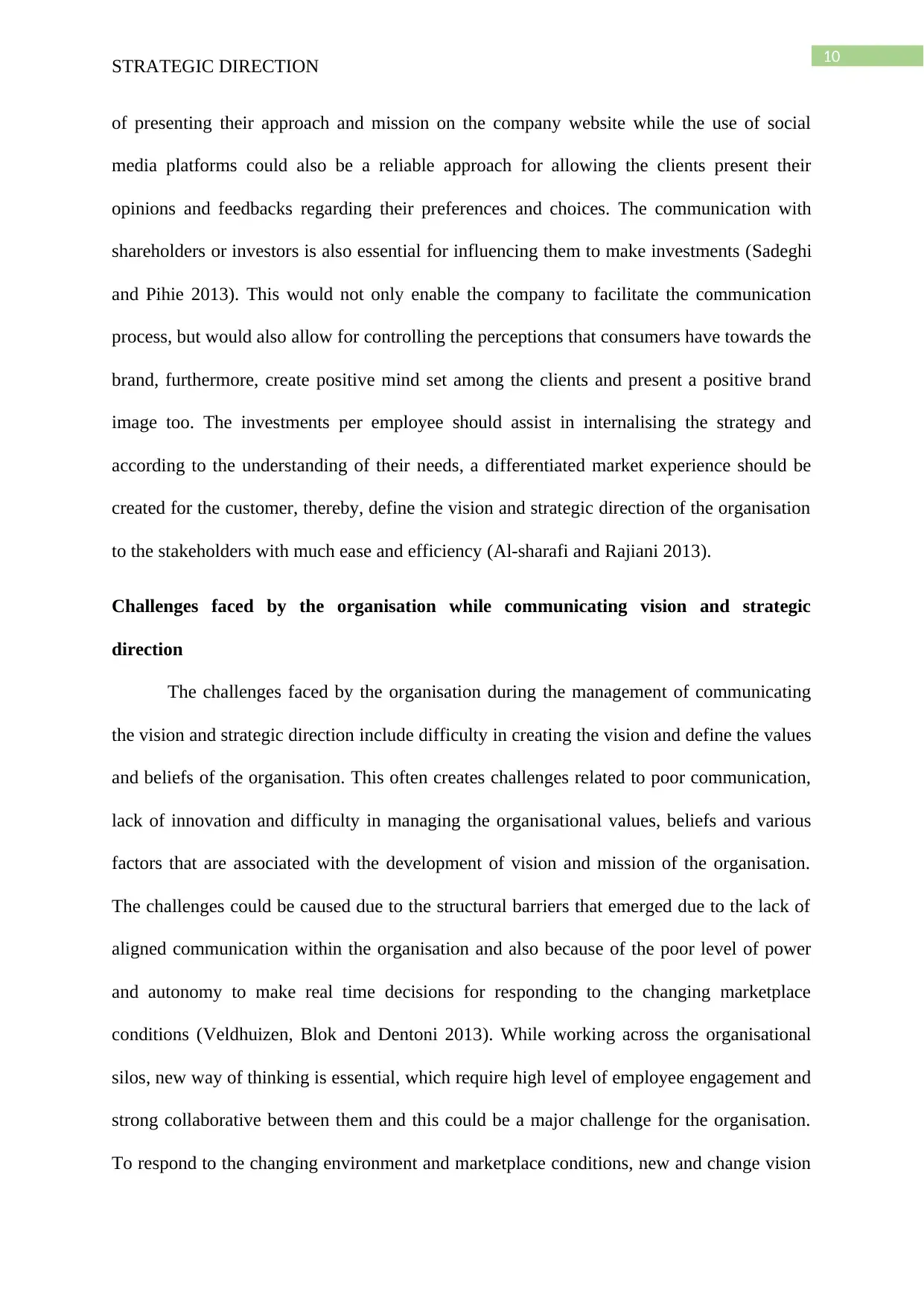
10
STRATEGIC DIRECTION
of presenting their approach and mission on the company website while the use of social
media platforms could also be a reliable approach for allowing the clients present their
opinions and feedbacks regarding their preferences and choices. The communication with
shareholders or investors is also essential for influencing them to make investments (Sadeghi
and Pihie 2013). This would not only enable the company to facilitate the communication
process, but would also allow for controlling the perceptions that consumers have towards the
brand, furthermore, create positive mind set among the clients and present a positive brand
image too. The investments per employee should assist in internalising the strategy and
according to the understanding of their needs, a differentiated market experience should be
created for the customer, thereby, define the vision and strategic direction of the organisation
to the stakeholders with much ease and efficiency (Al-sharafi and Rajiani 2013).
Challenges faced by the organisation while communicating vision and strategic
direction
The challenges faced by the organisation during the management of communicating
the vision and strategic direction include difficulty in creating the vision and define the values
and beliefs of the organisation. This often creates challenges related to poor communication,
lack of innovation and difficulty in managing the organisational values, beliefs and various
factors that are associated with the development of vision and mission of the organisation.
The challenges could be caused due to the structural barriers that emerged due to the lack of
aligned communication within the organisation and also because of the poor level of power
and autonomy to make real time decisions for responding to the changing marketplace
conditions (Veldhuizen, Blok and Dentoni 2013). While working across the organisational
silos, new way of thinking is essential, which require high level of employee engagement and
strong collaborative between them and this could be a major challenge for the organisation.
To respond to the changing environment and marketplace conditions, new and change vision
STRATEGIC DIRECTION
of presenting their approach and mission on the company website while the use of social
media platforms could also be a reliable approach for allowing the clients present their
opinions and feedbacks regarding their preferences and choices. The communication with
shareholders or investors is also essential for influencing them to make investments (Sadeghi
and Pihie 2013). This would not only enable the company to facilitate the communication
process, but would also allow for controlling the perceptions that consumers have towards the
brand, furthermore, create positive mind set among the clients and present a positive brand
image too. The investments per employee should assist in internalising the strategy and
according to the understanding of their needs, a differentiated market experience should be
created for the customer, thereby, define the vision and strategic direction of the organisation
to the stakeholders with much ease and efficiency (Al-sharafi and Rajiani 2013).
Challenges faced by the organisation while communicating vision and strategic
direction
The challenges faced by the organisation during the management of communicating
the vision and strategic direction include difficulty in creating the vision and define the values
and beliefs of the organisation. This often creates challenges related to poor communication,
lack of innovation and difficulty in managing the organisational values, beliefs and various
factors that are associated with the development of vision and mission of the organisation.
The challenges could be caused due to the structural barriers that emerged due to the lack of
aligned communication within the organisation and also because of the poor level of power
and autonomy to make real time decisions for responding to the changing marketplace
conditions (Veldhuizen, Blok and Dentoni 2013). While working across the organisational
silos, new way of thinking is essential, which require high level of employee engagement and
strong collaborative between them and this could be a major challenge for the organisation.
To respond to the changing environment and marketplace conditions, new and change vision
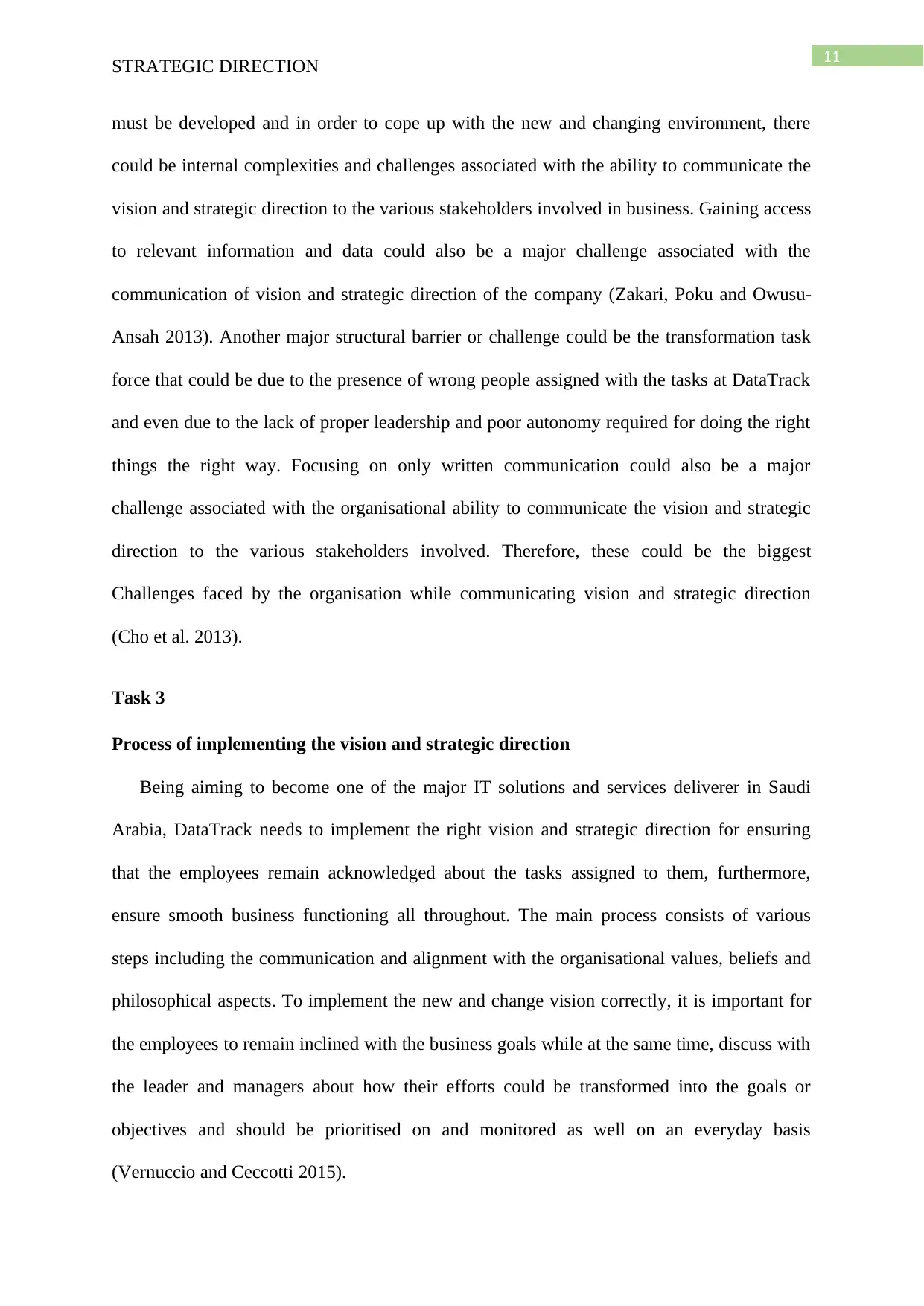
11
STRATEGIC DIRECTION
must be developed and in order to cope up with the new and changing environment, there
could be internal complexities and challenges associated with the ability to communicate the
vision and strategic direction to the various stakeholders involved in business. Gaining access
to relevant information and data could also be a major challenge associated with the
communication of vision and strategic direction of the company (Zakari, Poku and Owusu-
Ansah 2013). Another major structural barrier or challenge could be the transformation task
force that could be due to the presence of wrong people assigned with the tasks at DataTrack
and even due to the lack of proper leadership and poor autonomy required for doing the right
things the right way. Focusing on only written communication could also be a major
challenge associated with the organisational ability to communicate the vision and strategic
direction to the various stakeholders involved. Therefore, these could be the biggest
Challenges faced by the organisation while communicating vision and strategic direction
(Cho et al. 2013).
Task 3
Process of implementing the vision and strategic direction
Being aiming to become one of the major IT solutions and services deliverer in Saudi
Arabia, DataTrack needs to implement the right vision and strategic direction for ensuring
that the employees remain acknowledged about the tasks assigned to them, furthermore,
ensure smooth business functioning all throughout. The main process consists of various
steps including the communication and alignment with the organisational values, beliefs and
philosophical aspects. To implement the new and change vision correctly, it is important for
the employees to remain inclined with the business goals while at the same time, discuss with
the leader and managers about how their efforts could be transformed into the goals or
objectives and should be prioritised on and monitored as well on an everyday basis
(Vernuccio and Ceccotti 2015).
STRATEGIC DIRECTION
must be developed and in order to cope up with the new and changing environment, there
could be internal complexities and challenges associated with the ability to communicate the
vision and strategic direction to the various stakeholders involved in business. Gaining access
to relevant information and data could also be a major challenge associated with the
communication of vision and strategic direction of the company (Zakari, Poku and Owusu-
Ansah 2013). Another major structural barrier or challenge could be the transformation task
force that could be due to the presence of wrong people assigned with the tasks at DataTrack
and even due to the lack of proper leadership and poor autonomy required for doing the right
things the right way. Focusing on only written communication could also be a major
challenge associated with the organisational ability to communicate the vision and strategic
direction to the various stakeholders involved. Therefore, these could be the biggest
Challenges faced by the organisation while communicating vision and strategic direction
(Cho et al. 2013).
Task 3
Process of implementing the vision and strategic direction
Being aiming to become one of the major IT solutions and services deliverer in Saudi
Arabia, DataTrack needs to implement the right vision and strategic direction for ensuring
that the employees remain acknowledged about the tasks assigned to them, furthermore,
ensure smooth business functioning all throughout. The main process consists of various
steps including the communication and alignment with the organisational values, beliefs and
philosophical aspects. To implement the new and change vision correctly, it is important for
the employees to remain inclined with the business goals while at the same time, discuss with
the leader and managers about how their efforts could be transformed into the goals or
objectives and should be prioritised on and monitored as well on an everyday basis
(Vernuccio and Ceccotti 2015).
⊘ This is a preview!⊘
Do you want full access?
Subscribe today to unlock all pages.

Trusted by 1+ million students worldwide
1 out of 22
Related Documents
Your All-in-One AI-Powered Toolkit for Academic Success.
+13062052269
info@desklib.com
Available 24*7 on WhatsApp / Email
![[object Object]](/_next/static/media/star-bottom.7253800d.svg)
Unlock your academic potential
Copyright © 2020–2025 A2Z Services. All Rights Reserved. Developed and managed by ZUCOL.





